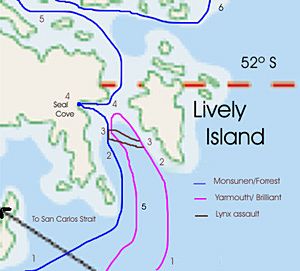Battle of Seal Cove facts for kids
Quick facts for kids Battle of Seal Cove |
|||||||
|---|---|---|---|---|---|---|---|
| Part of Falklands War | |||||||
 Sketch depicting the chase of the Argentine coastal vessel Monsunen by British frigates Details
|
|||||||
|
|||||||
| Belligerents | |||||||
| Commanders and leaders | |||||||
| Captain Anthony Morton (HMS Yarmouth) Captain John Coward (HMS Brilliant) |
Captain Jorge A. Gopcevich-Canevari (ARA Monsunen) |
||||||
| Strength | |||||||
| 1 Type 22 frigate 1 Rothesay-class frigate |
1 armed coastal ship | ||||||
| Casualties and losses | |||||||
| None | 1 coastal ship beached (later taken in tow and rescued by ARA Forrest) 1 wounded |
||||||
The Battle of Seal Cove was a small sea chase that happened near Lively Island during the 1982 Falklands War. On May 22, 1982, two British warships, HMS Brilliant and HMS Yarmouth, were ordered to find and capture an Argentine supply ship. This ship was called ARA Monsunen. Even though the British ships fired many shells, the Monsunen managed to escape. It did this by running aground (getting stuck on the shore) in a nearby bay.
What Happened Before
The ARA Monsunen was a 326-ton ship that used to belong to a British company. It was captured by Argentina when they invaded the Falkland Islands in 1982.
The ship was carrying important supplies. It had 150 drums of fuel and 250 sacks of flour. These supplies were needed in Stanley. A British RAF Harrier jet spotted the Monsunen sailing from Fox Bay.
The ship's commander, Captain Jorge Gopcevich-Canevari, said his ship had already avoided a British warship on May 14. That time, it was on a similar mission.
The Chase Begins
At 4:00 AM on May 23, a Lynx helicopter from HMS Brilliant found the Monsunen. The Argentine ship was heading north, west of Lively Island.
The British sent a radio message telling the Monsunen to give up. Then, another Lynx helicopter, carrying a special forces team called the Special Boat Service (SBS), tried to stop the ship. However, the Monsunen crew fired back with heavy machine guns and small guns. This forced the helicopter to fly away.
At the same time, the Monsunen's radar detected the two British warships. They were about 8 miles behind and coming very fast. An officer on the Monsunen, Oscar Vázquez, later said that HMS Brilliant was coming from the south. HMS Yarmouth sailed ahead to Choiseul Sound, blocking the way from the north.
Running Aground
HMS Yarmouth started firing its large 4.5-inch guns at the Monsunen. The small Argentine ship had to move quickly to avoid being hit.
When the British ships got closer, about 4 miles away, Captain Gopcevich made a bold decision. He decided the only way to hide from the British radar was to run his ship aground. He aimed for Seal Cove, a large bay nearby.
He successfully got his ship stuck on the shore. He then ordered his crew to leave the ship. The British shelling continued, but it was not very accurate. It seemed to be aimed at the general area where the ship landed.
During the escape, one crew member fell into the water. He was bruised but was quickly rescued by another young sailor. The crew members found shelter on land.
According to Officer Vázquez, the British warships fired 100 shells at the Monsunen. These shells included high-explosive and armor-piercing types.
The British warships decided not to send the SBS team to attack the grounded ship again. They were worried that Argentine troops might be hiding there.
After the Battle
The British frigates stopped their chase and left the area before the sun came up. HMS Yarmouth, with the SBS team, went to San Carlos waters. HMS Brilliant joined a larger group of ships to refuel.
At dawn, the Monsunen crew found their ship. Its engine was still running, and it seemed to have floated free with the rising tide. However, a rope had gotten tangled in its propeller, so it couldn't move properly.
With the ship unable to move fast, Captain Gopcevich radioed Stanley for help.
A few hours later, another British supply ship that Argentina had captured, ARA Forrest, arrived. It towed the Monsunen to Darwin. The important cargo was then moved to the ARA Forrest. This ship successfully delivered the supplies to Stanley on May 25.
The ARA Monsunen was later found by British forces at Darwin on May 29. This happened after the Battle of Goose Green.
This event is thought to be the only time armed surface ships fought each other during the Falklands War. Captain Jorge Gopcevich-Canevari was given a special award for his bravery.
Images for kids




